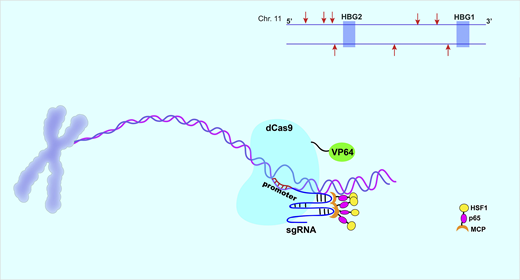Induction of hemoglobin γ expression is a reliable strategy to treat β-thalassemia. Gene editing using CRISPR/Cas9 technology has been widely used. However, application in vivo is limited due to the uncertainty on genomic cleavages of Cas9. In contrast, CRISPR/Cas9-based gene activation (CRISPRa) can only locate genomic locus but not interrupt sequence. Here, we use SAM system of CRISPRa to locate and activate HBG1 and HBG2, exploring the great potential of CRISPRa for β-thalassemia treatment.
WWe designed 8 single-guide RNAs (sgRNAs) online and cloned into vector SAM V2, which fused dCas9 and VP64. To test the over-expression efficiency, vector containing sgRNA and MPH (fused HSF1, p65 and MS2) were transfected into 293T cell. After 72h transfection, 293T cells were collected. Q-PCR data showed that two sgRNAs were excellent on activating HBG expression with over 1000-fold increase.
WTo test the activating function in hematological cell and the persistence of hemoglobin γexpression, two screened sgRNA were transfected into NB4 cells using lentivirus system. We harvested NB4 cells at different time-point (3 day, 1 week and 2 weeks), and implemented q-PCR assay. HBG expression were increased 50-hold and 1000-hold, respectively. However, the expression were reducing over time and the intrinsic mechanism is unknown.
WThis study set out to increase HBG without interrupt genome using CRISPRa system. This study has found two sgRNA to activate the expression of HBG in 293T cell and NB4 cell. Further research is required to vertify the efficiency of sgRNA in hematopoietic stem cells and prolong the expression time.
No relevant conflicts of interest to declare.
Author notes
Asterisk with author names denotes non-ASH members.


This feature is available to Subscribers Only
Sign In or Create an Account Close Modal